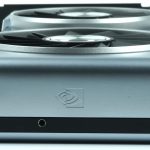The fact that the RTX 2080 is being sprinkled up a bit is one thing, because so far, according to distributors and board partners, this card has not really been the most sought-after model in the RTX series. Now there is the full expansion of the TU104, which can perhaps move a little closer to the GeForce RTX 2080 Ti. But overtaking without catching up has never worked and so you will probably be happy if this RTX 2080 Super for raytracing and higher resolutions brings at least a little more puff.
But what is more important is what is really hidden behind the GeForce RTX 2080 Super, what you can expect from it and what you might not expect from it. Because in the end only the result counts and so new is the chip again not, only this time finally also complete and complete.
Whether this GeForce RTX 2080 Super can still fill the function that an RTX 2080 often in vain was aiming for – you will have to see it. The will is somehow already there, only the buyer has to play along (and of course also the price, logically). After all, in the end, it is nothing more than a drilled-up RTX 2080, which for understandable reasons cannot be called Ti, but must be absolutely super. Which then probably explains the comical name-climbing that Nvidia had to come up with.
The TU104-450 of the GeForce RTX 2080 Super
Similar to the larger TU102, TSMC manufactures the TU104 on its 12 nm FinFET node. But a transistor number of 13.6 billion leads to a smaller, "only" 545 mm2 die-area. Of course, this also saves costs in the end. However, Turing Junior still surpasses the 471 mm2 of the GP102 as the flagship of the last generation and comes quite close to the size of the GK110 in the original GeForce GTX Titan.

The TU104 is made up of the same building blocks as the TU102; but there is only a little less of everything. The streaming multiprocessors still have 64 CUDA cores, eight tensor cores, an RT core, four texture units, 16 load/storage units, 256 KB of register memory, and 96 KB of L1 cache/shared memory. The TPCs also still consist of two SMs and a PolyMorph geometry engine. But there are now only four TPCs per GPC and the six GPCs are distributed across the processor. Therefore, a fully functional TU104 has a total of 48 SMs, 3072 CUDA cores, 384 tensor cores, 48 RT cores, 192 texture units and 24 PolyMorph engines.
A correspondingly narrower back-end implements the connection via eight 32-bit GDDR6 memory controllers (256-bit aggregate) connected to 64 ROPs and 4 MB L2 cache. However, Nvidia gives the GeForce RTX 2080 Super the slightly faster memory at 16 Gbps, instead of the 14 Gb/s of the smaller models. Unfortunately, the TU104 also loses one of the two x8 NVLink connections of the TU102, which then limits the whole to an x8 connection and 50 GB/s bidirectional throughput.
Unboxing and technical data
Compared to the GeForce RTX 2080 FE, the map also has a slight visual change, with the reflective surface on the cover being a great fingerprint file. As with the RTX 2080 FE, the connectors rely on three DisplayPort ports and an HDMI 2.0 port. The USB Type-C jack is also at the start, NVLink is also available at the top of the board. The rest is as usual and for the details there is also the complete tear down.
A first overview gives us here GPU-Z:
The table gives a nice overview of the technical data of the current GeForce RTX Super and the older comparison models:
| Nvidia GeForce RTX 2060 Super |
Nvidia GeForce RTX 2070 FE |
Nvidia GeForce RTX 2070 Super |
Nvidia GeForce RTX 2080 FE |
Nvidia GeForce RTX 2080 Super |
|
| Architecture (GPU) |
TU106-410 | TU106-400 | TU104-410 | TU104-400 | TU104-450 |
| CUDA Cores |
2176 | 2304 | 2560 | 2944 | 3073 |
| Tensor Cores |
272 | 288 | 320 | 368 | 384 |
| RT Cores |
34 | 36 | 40th | 46 | 48 |
| Texture Units |
136 | 144 | 160 | 184 | 192 |
| Base Clock Rate |
1470 MHz | 1410 MHz | 1605 MHz | 1515 MHz | 1650 MHz |
| GPU Boost Rate |
1650 MHz | 1710 MHz | 1770 MHz | 1800 MHz | 1815 MHz |
| Storage expansion |
8GB GDDR5 | 8GB GDDR6 | 8GB GDDR6 | 8GB GDDR6 | 8GB GDDR6 |
| Storage bus |
256-bit | 256-bit | 256-bit | 256-bit | 256-bit |
| Bandwidth |
448 GB/s | 448 GB/s | 448 GB/s | 448 GB/s | 496 GB/s |
| Rops |
64 | 64 | 64 | 64 | 64 |
| L2 Cache |
4 MB | 4 MB | 4 MB | 4 MB | 4 MB |
| Tdp |
175 W | 185 W | 215 W | 225 W | 250 W |
| Transistors |
10.8 billion | 10.8 billion | 13.6 billion | 13.6 billion | 13.6 billion |
| The size |
445 mm2 | 445 mm2 | 545 mm2 | 545 mm2 | 545 mm2 |
| Sli |
No | No | NVLink x8 | NVLink x8 | NVLink x8 |
Test system and measurement methods
The test system and the methodology are well known, but since I am now independently testing here in Germany, the test system has also been upgraded again without having to take into account colleagues.
If you are interested, the summary in table form quickly provides a brief overview:
| Test systems and measuring rooms | |
|---|---|
| Hardware: |
Intel Core i9-9900 KF MSI MEG Z390 ACE 2x 8GB KFA2 HoF DDR4 4000 1x 1 TByte Patriot Viper (NVMe System SSD) 1x Seagate FastSSD Portable USB-C Be Quiet Dark Power Pro 11, 850-watt power supply |
| Cooling: |
Alphacool Ice Block XPX 5x Be Quiet! Silent Wings 3 PWM (Closed Case Simulation) Thermal Grizzly Kryonaut (for cooler change) |
| Housing: |
Lian Li PC-T70 with expansion kit and modifications Modes: Open Benchtable, Closed Case |
| Monitor: | Eizo EV3237-BK |
| Power consumption: |
non-contact DC measurement on the PCIe slot (Riser-Card) non-contact DC measurement on the external PCIe power supply Direct voltage measurement on the respective feeders and on the power supply 2x Rohde & Schwarz HMO 3054, 500 MHz multi-channel oscillograph with memory function 4x Rohde & Schwarz HZO50, current togor adapter (1 mA to 30 A, 100 KHz, DC) 4x Rohde & Schwarz HZ355, touch divider (10:1, 500 MHz) 1x Rohde & Schwarz HMC 8012, digital multimeter with storage function |
| Thermography: |
1x Optris PI640, 2x Xi400 Infrared Cameras Pix Connect evaluation software with profiles |
| Acoustics: |
NTI Audio M2211 (with calibration file) Steinberg UR12 (with phantom power for the microphones) Creative X7, Smaart v.7 own low-reflection measuring room, 3.5 x 1.8 x 2.2 m (LxTxH) Axial measurements, perpendicular to the center of the sound source(s), measuring distance 50 cm Noise in dBA (Slow) as RTA measurement Frequency spectrum as a graph |
| Operating system | Windows 10 Pro (1903, all updates), driver current |











































Kommentieren